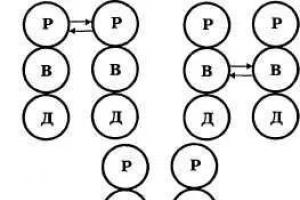Pruning adenium as a stage in the formation of the crown and caudex of a plant at home is a fascinating activity, but not all gardeners know how to do it correctly. At what age is the crown and roots of adenium pruned? How to do this correctly? Replanting a plant and simultaneously forming a caudex. In this case, the recommendations of specialists with a detailed explanation of questions about pruning adenium and how to care for the plant afterwards will be useful.
So, step-by-step photo instructions on trimming the crown and roots of adenium. Caudex formation and plant transplantation.
Trimming the crown of adenium
Before pruning the crown of adenium, it is necessary to understand the concept of “apical dominance”. In this case, we are talking about the dominance of some dormant plant buds over others. As a rule, the topmost bud on the shoot develops fastest in adenium. This is determined by the distribution of hormones in the plant. Thus, auxin hormones (they are responsible for the growth of branches in a plant) are more concentrated in the upper part of the shoot, while the lower part of the plant receives them to a lesser extent. As adenium ages, the concentration of auxins in the stem levels out and it begins to branch independently without any pruning. However, in order for adenium to begin to branch independently, that is, auxin hormones are evenly distributed along its stem and give impetus to the growth of new branches from dormant buds, the age of the plant must exceed 4-5 years. Consequently, experts recommend pruning adenium to form a lush and beautiful crown.
Adenium needs pruning for:
1. Formation of a lush and beautiful crown.
2. Stimulating the growth of lateral branches.
3. Rejuvenation of an adult plant whose age exceeds 5-6 years, which, in turn, stimulates abundant flowering. After all, as you know, on old branches of adenium, less and less is planted every year. fewer buds. Pruning old branches causes the growth of young shoots, and several times more buds appear on young branches compared to old branches.
When to prune adenium? Many gardeners suggest not pruning, but pinching young adenium shoots, that is, they only cut off the top of a plant whose age does not exceed 1 year. What happens when pruning adenium before 1 year? In most cases, 1 dormant bud wakes up, which is closest to the place where the apex is cut. As a result, after pruning, only one branch begins to develop, which replaces the cut top.
It is recommended to trim the crown of adenium, the age of which is equal to 3-5 years. The plant must have a fairly wide caudex. In this case, more dormant buds will “wake up”, which will result in a lush crown. However, there is one more nuance - this is the timing of pruning. It is advisable to prune the adenium crown in the spring, but only after the flower has woken up from winter rest and entered the active growth. If trimming is done in early spring When the flower is still sleeping, 1-2 buds will wake up on the stem.
It is not recommended to prune adenium in autumn and winter. At this time, the plant goes to rest or is already sleeping. Side branches do not develop, and the flower may die. It is not recommended to prune young adenium (plant age 1-2 years). His caudex is just forming. The size of the caudex depends on the amount of green mass of the flower. If the latter is removed, the caudex will be small.
How to prune adenium? Experts point to a universal method for pruning adenium - the height of the remaining cutting should not exceed 9 cm. If you trim close to the caudex, many dormant buds will awaken. The result will be a lot of thin branches, which is not very beautiful for adenium. If you cut only the top of the dominant branch (the length of the resulting cutting does not exceed 5 cm), then only a replacement branch will develop. It will grow upward and the pruning simply will not be noticeable.
Photo experiment on pruning the crown of adenium
The photo experiment examines several options for pruning adenium. This guide will help gardeners create a beautiful plant crown. So, pruning was carried out on seedlings whose age had reached 3.5 years. In this case, the width of the caudex in diameter was 1.5-2 times greater than the width of the stem in diameter.

In the first photo, the cutting height was 5 cm, that is, the entire ground part of the flower was cut off. Only the cutting was left, 5 cm high from the upper edge of the caudex. As a result, up to a dozen sleeping buds woke up. During the growth process, not all branches survived, but the result was a lush crown of adenium.

In the second photo, the height of the cuttings left relative to the level of the caudex was about 10 cm. As a result, about 5 dormant buds woke up, which is much worse compared to the previous pruning option. During the growth process, some branches died. The remaining branches were pruned again, which made it possible to form a lush crown of adenium. But this option pruning delayed the flowering of the plant for a year.

In the third photo, only 5 cm of the plant crown was removed. As a result, only a replacement branch develops, which stretches upward. That is, if you trim the adenium just a little, you won’t get a lush crown. Only one bud will wake up from which one branch will develop.
The photo below shows the results various options pruning and shaping the adenium crown.

There is another option for trimming and shaping the adenium crown. The entire stem of the plant and the upper part of the caudex are cut off, that is, deep pruning is carried out. As a result, up to 15 sleeping buds wake up. During the growth process, not all formed branches survive, but the number of remaining shoots is very large, which is considered unsightly for adenium.

There are several basic rules for pruning and forming the crown of adeniums:
2. All weak shoots should be removed. They will dry out on their own over time, but their timely removal stimulates the growth of healthy plant branches.
4. The number of branches of the second, third, and so on order should increase according to a geometric progression.
5. When thinning the crown of an old adenium, cuts on the branches must be made at the dormant bud, which looks outside the crown. In this case, measure 5 mm higher up the stem from the dormant bud, and cut off the rest of the part (what remains above).
Do not prune if the plant is sick. More details about adenium diseases. Why do adenium leaves and soft caudex dry out??
Trimming and forming adenium crown in photo
2 days before pruning, adenium must be watered. This watering should be planned; the flower should not be over-watered. The explanation for this state of affairs is simple: we cut off the crown of the plant, and along with it the leaves. Leaves are the main agent in the process of evaporation of moisture from a flower. In waterlogged soil and without leaves, adenium will have nowhere to put excess moisture and it may rot.
If a transplant has been carried out, it is better not to prune for at least 2 weeks after transplantation. Although many gardeners recommend replanting and pruning the crown at the same time, this is wrong, since many people cut off the roots during replanting. If at the same time the crown of the adenium is removed, it may die.

1 step. The plant itself is prepared, with which a sharp blade will work. It is better not to use it anywhere in the future, since adenium juice is poisonous. It is also recommended that after pruning, place the plant out of the reach of children and pets.

Step 2. Trim the adenium crown to the required height, as described above. The cuttings that have formed can be rooted. Of course, the caudex of a rooted cutting will develop more slowly compared to the caudex of adenium from seeds, but in this way you can get two from one plant.

Step 3. Juice will begin to ooze out from the cut. It is removed with a napkin. After the juice stops oozing, the cut area must be lubricated with garden varnish or a special paste. It can be purchased at flower shop. Colloidal sulfur and crushed activated carbon are not used to coat adenium cuts. They are more suitable for roots. If you use them, you get an unsightly cut that takes a long time to heal.

Important!!! After trimming, you can put on adenium plastic bag. This way the cutting area is kept in a moist environment. This, according to experts, stimulates wound healing and awakening of dormant kidneys. Cytokinin paste can be used to grow dormant buds.
Intensive growth of branches begins in the period from 14 to 45 days. It all depends on the conditions of the flower.
Pruning adenium roots
In what cases is adenium root pruning carried out? This is done during the formation of the caudex, less often - during rotting of the root system.
So, the most popular way of forming the caudex in adenium is the octopus. In this case, all the roots of the plant are cut off on that part of the caudex that tapers downwards. If you don’t want to trim the caudex and thus form roots in the adenium, you can simply raise its root system slightly above the ground when replanting the plant.
When is the first pruning of adenium roots carried out? Some gardeners suggest cutting off the main crown of adenium already at the age of 1-3 months. After removing the central root, the lateral root system begins to grow rapidly and increase in volume. By lifting it above the ground while replanting the plant, you can form a lush caudex of a bizarre shape. But as practice shows, cutting off the central root of seedlings at the age of 1-3 months does not lead to anything good. In some cases, the flower begins to develop one replacement root, which will dominate over time and a fancy root system will not form. But for the most part, seedlings react painfully to cutting the central root, slow down their growth, and when improper care rot.
It is too late to prune the roots if the adenium is already 2-3 years old. This plant is already fully formed; complete removal of the roots (if you want to form an octopus) can lead to its death. With an adult adenium, you can proceed as follows: trim its crown (this way the sleeping buds on the stem wake up and a lush crown is obtained). The remaining cuttings are rooted. A rooted cutting does not produce a central root, but develops lateral roots. By correctly directing the latter, you can form a large caudex in the form of an octopus.
It is recommended to trim the roots of seedlings up to 1 year old (5-6 months). In such seedlings, either one central root is removed, or the entire lower part of the caudex is cut off, which makes it possible to form an octopus.
Pruning and formation of an octopus in an adenium seedling
For the first pruning, strong adenium seedlings, up to a year old, are selected, although you can experiment with young seedlings up to six months. In the latter case, you need to be prepared for the plant to slow down its growth. Although, if you take very small seedlings that have not yet had time to properly form a central root, then pruning will not be necessary. When replanting, it is enough to spread the roots of the flower in a circle on a thick plate and sprinkle with earth. Over time, the roots will begin to grow and an octopus will form.
Photo instructions for the formation of an octopus caudex in an adenium seedling:
Important!!! Pruning of adenium seedlings is carried out during the period of intensive growth. If the seeds were planted in the fall, then the period of intensive growth of the seedlings begins in May-June, then the central root can be trimmed. It is not recommended to cut off the crown of the plant at the same time.

1 step. Seedlings up to 1 year old are removed from the ground. Their root system is cleared of soil and can be washed. This makes pruning easier.
Step 2. Using a sharp, sterile blade, cut off the central root of the adenium. You need to be very careful, because the sap of the plant is poisonous. It is recommended to blot the sections with a napkin. After the juice on the cut ceases to stand out, it is filled with either molten paraffin or sprinkled with crushed activated carbon.
Step 3. It is necessary to let the sections dry. Some do this within 3 days, but as practice shows, during this time the cuttings lose a lot of water and become lethargic. Such planting material takes root very poorly. Experts recommend drying cut adeniums for no more than a day. This is done in a dry place in partial shade.
Step 4 Rooting of adeniums is carried out in perlite, which is well moistened. First, you need to put a piece of plastic cut into a circle into the perlite. Adeniums are placed on it and sprinkled with soil.
Important!!! Upper layer The soil where the adenium is located on the plastic mug dries out very quickly. It must be regularly moistened with a spray bottle.
After pruning, adenium is placed in a sunny place. The content temperature should be within +25...+30 degrees. The higher the temperature of the plant, the less likely it is that the cut site will rot. It is not necessary to organize a greenhouse over the seedlings. It is enough to spray them with warm water 1-2 times a day.

After pruning, the roots begin to grow within 1 month. Adenium is removed from perlite. You can notice tightly tangled roots that, with the right approach, grow in a circle. They are unraveled, weak roots are trimmed. In order for the adenium roots to grow in the desired direction, the plant is returned to the plastic circle, while the root system is slightly raised above the ground. You can put pieces of foam between the roots or secure the roots in the desired direction with toothpicks.
Succulents can be more than just nondescript “fat creatures” - residents of rocky gardens. Some of them are stunningly beautiful plants with bright, expressive flowers. Place a fairy-tale tree on your windowsill, covered with many small pink flowers, - adenium. Adenium is also called Desert Rose or Star of Sabinia, Impala Lily.
Little known until recently, adenium has gained wide popularity among gardeners due to its exotic appearance and ease of care. Delicate, delightful flowers covering the crown of a tree can evoke admiration from anyone.
About 50 species of Adenium are known, in nature there are specimens up to several meters in height! In indoor floriculture, one species is common - adenium obese, very similar to bonsai. However, you don’t have to tinker with adenium much: the tree itself takes on bizarre shapes that are so attractive to the eye, only requiring a little pruning and pinching.
How to care for adenium at home
Caring for adenium is as simple as possible, so you don’t need to remember any tricks. A novice florist or an experienced lover, everyone will appreciate the unpretentiousness of the flower. The main features of agricultural technology are easy to remember; we will tell you more about them in the article.
Lighting
Adenium loves a lot of light, so south windows - the best place where you can stay exotic. Only with the onset of hot summer, when the rays of the sun become especially hot, is the plant transferred to eastern or western windowsills so that burns do not appear on the trunk and leaves.
Temperature
On warm summer days, when the air temperature reaches 25-30°C, adenium feels great. With the onset of autumn, when the air temperature drops and the days shorten, the plant slowly enters a dormant period. Therefore, with the arrival of winter, it is advisable to maintain this state by placing adenium in a cool room, where the temperature will be about 12-15°C, but not lower than +10°C.
How to water adenium
Considering that adenium is a succulent, you should not be overzealous with watering. The plant tends to accumulate moisture in its fleshy tissues. Therefore, let the top layer of the earth dry out a little so that the adenium feels comfortable. This watering regime will especially appeal to lazy gardeners who remember the existence of green pets only on weekends.
In summer, when the plant is actively growing green mass, watering can be done more often, but little by little, so as not to over-moisten the soil. During the dormant period, watering is kept to a minimum, moistening only occasionally to prevent the soil in the pot from drying out.
Air humidity
The air humidity in the apartment is quite sufficient for the active development of adenium. In the spring, before flowering begins, it responds well to spraying from a spray bottle. When flower stalks appear, spraying should be stopped: this can provoke the appearance of rot, so it is better not to risk it.
How to fertilize adeniums for better growth

Sold in a flower shop complex fertilizer for succulents. It is advisable to purchase it and fertilize the plant in the spring, during the period of active growth. The main elements that a plant needs for growth and development and the formation of flower buds are phosphorus, potassium and nitrogen. The main thing is not to overdo it and follow the recommendations specified by the drug manufacturer.
Remember, “overfed” succulents are able to increase the mass of the trunk, reducing the volume and duration of flowering. Therefore, feed no more than twice a month, and strictly according to the instructions.
Soil for adenium
In order not to put yourself and the plant through tests, it is best to purchase ready soil for, having the necessary characteristics in terms of physical and chemical parameters. The soil should be loose, well-drained and nutritious.
Why do adenium leaves turn yellow?
If the lower leaves turn yellow in autumn or winter, there is no need to worry: this is a sign that the succulent has entered a dormant period and is shedding excess leaves to make it easier to endure hibernation.
If the problem is noticed in spring and summer, when the plant is in the active phase, pay attention to the conditions under which it is kept. This may be a sign of hypothermia, exposure to a draft, or insufficient watering.
Adenium transplant
Young adeniums grow actively, quickly exhaust the supply of nutrients in the soil, occupy the entire area allotted to them, so that the roots become crowded. Therefore, in the spring, from March to May, succulents are transplanted into a larger pot, trying to carefully partially replace the soil.
By the way, do not forget that succulents should not be watered after transplantation. Wait a couple of days, let the damaged roots dry out and heal the wounds, then carefully, little by little, resume watering.
Pinching, trimming and forming the adenium caudex video
If you want to get a unique branchy crown of a mini-tree, don’t be lazy about pinching and pruning it. Pruning is aimed at forming the crown and stimulating branching. Pinching has the same goals; it is carried out on seedlings obtained from seeds.
How to form roots in adenium
Keep in mind that the roots of adenium grow strongly, which is why the plant is gradually displaced above the surface of the earth. If the roots have risen more than 1-2 cm above the ground, they need to be trimmed urgently. To do this, the plant is freed from the pot, the lateral roots are cut off, and transplanted into a deeper pot.
The video will tell you about pinching seedlings and cutting the roots of adenium:
Reproduction of adenium at home
Adenium can be propagated by seeds and cuttings.
Adenium from seeds

You can plant one at a time peat cups or even soak them in gauze until they sprout, and then carefully plant them in a nutritious soil mixture.

Young seedlings are actively growing and respond well to watering and adequate lighting. The air temperature should not fall below 14°C or rise above 30°C.
When the plants become crowded in temporary cups, they are carefully transplanted along with a lump of earth onto permanent place, shortening the central root to encourage the development of lateral roots.
How to grow adenium from seeds video:
The advantage of growing adenium from seeds is that adult plants will have a caudex - a characteristic thickening at the bottom of the central trunk of the tree. Seedlings obtained by cuttings do not have such thickening.
Propagation of adenium by cuttings
The fastest and easiest way to propagate adenium is to root trees cut during pruning apical cuttings 10-15 cm long.
Before planting, sprinkle with crushed charcoal (or activated) at the cut site and allow to dry until a thin, dry skin forms. After this, they are planted in slightly moist soil, but do not water. Only after two or three days will it be possible to carefully moisten the soil occasionally with a spray bottle and resume watering only after noticing the growth of new shoots.
Pruning adeniums Adeniums are very interesting and often unpredictable plants. You can sow seeds of the same species, even from the same pod, but get seedlings that are significantly different from each other. The shape of the leaves, the color and size of the caudex, the branching of the root or green part. Yes, yes, branching is also a genetic feature. Some “babies” can develop two or three growth points from birth, while others will stubbornly grow one. And even pruning doesn’t always help. So, general rules: 1. Any pruning should be done no earlier than spring. Without bright sun and long daylight hours, there is a high chance that adenium will produce one leading shoot. 2. Adenium juice is poisonous. True, even if you bite off the top of a twig with your teeth, the maximum you will experience is a terrible bitterness, which will be very difficult to get rid of. But this juice will perfectly oxidize metal blades. 3. It is not necessary to treat the wounds with anything, but if it happens a large number of juice, you should blot it with a napkin to avoid unsightly drips. 4. The lower the cut line, the more buds can wake up. 5. Trimmed adenium drinks less water, especially if it has few leaves left. Be careful. 6. Trimmed seedlings should be placed in the brightest place, this will stimulate the development of buds. 7. There is an opinion that pruning seedlings delays their flowering. I don’t know how similar an experience can be compared, however, many grafts, even after serious pruning, do not stop producing buds if the conditions are suitable. They release them from the lateral buds, along with the first leaves. 8. If only one of several branches of adenium wakes up, it needs to be cut lower than the rest, this should stimulate the development of buds. 9. Any fertilizing after pruning should be based on the rule: nitrogen stimulates the growth of green mass, but also lengthens the distances between leaves. Therefore, you need to choose those where N (nitrogen) is less than other substances, or the same. Better first time to make do with stimulants, waiting until 2-3 pairs of leaves grow. 10. All adeniums have different buds that wake up after pruning. This may take about 10 days. Let's move on to a detailed consideration. Point 1. Pruning seedlings from 2.5 to 4 months. After one old video from Taiwan, where, during transplantation, young adeniums were pruned on both sides, many began to remove the growing point and central root of seedlings under four months of age. It is believed that this procedure allows you to obtain plants that will actively branch and have beautiful roots, avoiding the problem of unaesthetic scars. Let's look at this procedure in more detail. What are the advantages of pinching the growth point early? 1. You can really get beautiful branching already on young seedlings. 2. The scar from such a cut will be completely invisible. What are the disadvantages? 1. Small seedlings very often do not develop such a number of branches, so in the end only one, a replacement shoot, grows normally. 2. Simultaneous pinching of the crown and root will seriously inhibit the development of adenium. 3. Abundant branching from birth, according to the experience of some masters, leads to the fact that the seedling grows more slowly and blooms later. Point 2. Pruning plants from 1 year. The larger the adenium, the higher the chance of getting abundant branching after pruning. The height at which it should be carried out is everyone's personal preference. There are those who like to form adeniums like trees. Are there fans? classical forms. Different methods may be suitable for different purposes: 1. If your adenium is already branching, but one of the branches is developing much faster, suppressing the growth of the others, then you can “blind” it - burn it or pluck out the very top of the head. 2. If you do not want abundant branching (no more than 2 branches), but want to shorten the seedling, then cutting at an angle is perfect - from one leaf to another. As a rule, after such pruning, 1-2 buds begin to develop, next to which the cutting line was drawn. After some time, the scar disappears almost completely. 3. If you want abundant branching from the level of the caudex, you need to do deep pruning, leaving a small reserve in case only one bud wakes up the first time. It is better to make a straight cut. 4. One of interesting ways pruning, to obtain two growth points, is to cut a small wedge in the center of the trunk. This experiment happened to me by accident - the result of an unsuccessful vaccination. Finally, I want to say: there are adeniums that, even after repeated pruning, stubbornly grow only one branch. In this case, self-vaccination can help. The crown cutting is grafted into the main trunk with a wedge, or into the caudex itself under a drill. There is also an option with cytokinin paste, but on adeniums it gives a completely unpredictable result. Very often, the treated buds swell, becoming the size of a pea and stop there. PHOTO: 1-2 – pruning seedlings at the age of 2.5 months. 3-4 is the result. Some branches remained undeveloped, but the scar completely disappeared 5 - if adenium is prone to branching, it branches itself, but one shoot, most often, is in the lead. 6-7 – pruning large adeniums almost always ends in lush branching. But, if there is not enough light (7 photos), there are rarely more than 2 branches 8-9 - when pruning from one leaf to another (oblique cut), the scar can disappear almost completely, even on an adult seedling 10 - formation like a “tree” . During pruning, only the growing point was damaged. Author of the article and photo Nastya Volkova
The Adenium plant is a representative of the Kutrovaceae family. His homeland is Saudi Arabia. Translated from some languages, it is called adenium desert rose.
Adenium flower is a compact tree with a fleshy trunk, grows rather slowly, the main half of the thickened trunk is above the ground. The shoots of adenium are branched, and the leaves are elongated with a glossy appearance and a slightly pointed and rounded end.
Adenium inflorescences are distinguished by their individuality and beautiful appearance; they are large in size and have an interesting shade ranging from light to rich crimson. Interior The flower has a lighter shade.
It should be noted that when pruning adenium releases poisonous substance, after working with a flower, you must wash your hands well.
Adenium types and varieties
The adenium family represents approximately five species, and all the rest are subspecies.
or another name adenium obese . The plant develops slowly, its trunk is woody, and significant branching begins in the upper part. The height of the plant is approximately 1.5 meters, and the diameter of the trunk exceeds the mark of more than a meter. Grayish shoots with a thick fleshy base. Light green leaves with a long base grow on the upper shoots, reaching a length of about 10 cm.
In summer, the plant is about 5 cm in diameter with bright pink, red or light petals. Growing this plant at home, its height can reach about 70 cm, it all depends on the conditions of care and the abundance of moisture. Some tribes used its poison to create poisonous arrowheads.

natural habitat is the south of the Arabian Peninsula. It is worth noting interesting fact, if the plant does not have enough water, then the adenium remains in the form of a bush with a large root system. And if there is enough water, the plant develops and becomes a tree.
The leaves of this plant are outwardly shiny and larger in size than those of the obsessum, and with age they become up to 20 cm long and about 11 cm wide. The trunk reaches up to one meter in diameter. Adenium arabicum grows well at home and is a fairly unpretentious plant.
Flowering begins in the third year after planting. The first inflorescences begin to appear in the second half of winter. The most striking feature of Adenium Arabicum is its caudex, this is its appearance and extended base.

This is the brightest representative among other species. It is an actively branching bush, which blooms unusually and very actively from the moment of planting. Its growth is slow, like all species. The peculiarity that the plant has is its inconsistent varietal characteristics after breeding work, differences in color and shape.

his homeland is the coast of Mozambique. This species forms various interesting hybrids with Adenium obsumum. This plant is a shrub, its identity is its rhizome, but by the fifth year of growth it disappears. Flowering in this species occurs in cold and dry time, in winter. The inflorescences are white with a red edge. There are also red, burgundy and pink shades with inflorescences up to 7 cm in diameter.

Adenium care at home
Caring for adenium does not take much time and effort, so the plant is quite popular among gardeners.
Adenium is a heat-loving plant that develops well even when exposed to sun rays. Sufficient lighting is a necessity for adenium in care and maintenance, so the south side is what it needs. The plant on the windowsill must be constantly turned around so that it grows evenly and does not “crook the top.”
For adenium at home, it is necessary to maintain a temperature of 24 to 35 degrees; this is necessary during active development from autumn to spring. Moisturizing does not play a big role; you can sometimes spray it in the summer and only the leaves, do not touch the flowers.
IN autumn time, when the sunny day shortens for adenium, a state of rest begins. In some varieties, some of the leaves fall off, and sometimes all of them. IN winter time adenium can withstand temperature drops of up to 10 degrees, but it is important not to overwater the plant during this period, otherwise you risk losing the plant due to a fungal infection.

Adenium watering
Watering in spring and summer, when active development takes place, needs to be moistened regularly and abundantly. In winter, watering is reduced and moistened as necessary when the soil cover dries out. Water for irrigation needs soft, room temperature and slightly sour.
Adenium blooms from spring to autumn. The inflorescences are large and bloom in large numbers. Bouquets of flowers are located at the ends of the branches.

Adenium transplant
For adenium, transplantation is carried out as needed, but in good conditions adenium can develop quite quickly. The first transplant is required at about three months of age.
The thickness of the shoots usually reaches one centimeter. Adenium is transplanted in the evening or in cloudy weather and is not moistened for several days. If it turns out that the transplant happened during daylight hours, then after transplanting the plant must be moistened.

How to transplant adenium
The plant is taken out of the container and inspected for the presence of putrefactive formations. At the bottom of the new container, add drainage and a small amount of soil and place the seedling there, sprinkle the soil and make sure that it replaces the void between the roots. After transplantation, the plant is placed in a dark place for a couple of days. Young plants prefer moderate watering.

Soil for adenium
For adenium, the soil for transplantation is of particular importance. The ideal soil for adenium is light and moisture-permeable, with a sufficient amount of fertilizer and a neutral or acidic reaction.
You can purchase ready-made soil and add perlite or vermiculite to it, but ensure that its amount does not exceed 20%. You can buy ready-made soil for terrestrial orchids. You can also prepare the soil yourself. The composition of such soil for adenium should include coconut fiber or peat, deciduous soil or humus, coarse sand, perlite, and the ratio (5: 2: 1: 2).

Why doesn't adenium bloom?
Due to improper maintenance conditions, sometimes adenium stops flowering. The reason may be a large amount of fertilizer, because of this the flower goes well into the foliage, but does not bloom. Also, there may be a disadvantage sunlight, rotting of the root system and abundant watering in the cold season and improper observance of a state of rest for adenium.
Therefore, in order to make the plant bloom at home, you must follow these care rules.

The process of growing adenium from seeds takes place in stages:
Before sowing, the seeds are soaked for several hours in warm water, adding a growth stimulator to it. To successfully grow adenium from seeds at home, you need to properly prepare the soil. The composition of the soil is peat for succulents with a soil loosener, one to one. Coarse sand or perlite, fine charcoal or expanded clay can serve as a ripper. If there is no peat, take coconut fiber.
Before planting adenium seeds in the ground, you need to choose a container; it is better to give preference to small pots with holes or disposable cups. At the bottom we arrange drainage from brick chips, small pieces of polystyrene foam or charcoal, and at the end there is soil.
We plant the seeds on top of the ground and press them gently into the ground. Cover them with cling film or you can use cut-off material to cover them. plastic bottle. Moistening of adenium seeds must be done moderately from a spray bottle.
The temperature must be maintained at about 25 degrees, periodically ventilating your seeds. After the adenium seedlings have germinated, they are placed in a fairly well-lit warm room so that they begin to actively develop. The timing of germination may vary depending on the variety, but in about a few weeks.

Caring for adenium seedlings
When the seedlings grow several leaves, they should be replanted. In adenium, seedlings need to be transplanted after germination about three times during the year, as they grow. Adenium planted from seeds begins to bloom after a couple of years. Caring for seedlings, like all plants.

When to feed adenium seedlings
It is necessary to feed once a month with mineral and organic liquid fertilizers. This must be done during active growth and during flowering. To achieve lush leaves, you need to apply fertilizer with nitrogen at the beginning of spring. Flowering time can be extended by adding phosphorus or potassium.

Trimming adenium at home
To form the roots of the adenium, the so-called caudex, you need to lift it a little with each replanting. But not too high above the ground, as this can stop its development.
You can form adenium at home. In adenium, crown formation is not always the final result that you expected. To do this, you need to be patient. Young individuals are simply pinched, and a trunk is formed from adult adeniums using pruning.

How to prune adenium correctly
Pruning adenium is what larger diameter shoots, the larger the cutting area needs to be, and this promises many new stems at the cut site. Form the crown pruning of adenium as you would like to see your plant in your interior.
It should also be taken into account that if adenium is cut too low, the plant will grow irregular thin stems. The best period for pruning is the beginning of active growth. New branches appear at the cut site within a month and a half.
For adenium, root pruning is a real art. Proper root formation will give your plant an exotic appearance. Root pruning must be done on mature plants.
There are many interesting formations. One of these is when adenium is planted on a round plate, thanks to which the root system grows to the sides like an octopus.
The roots must be secured in the required position using sticks or toothpicks.

Diseases and pests of adenium
Adeniums are rarely susceptible to diseases; this may be caused by failure to comply with the conditions for caring for the plant.
Adenium sheds leaves what to do - most likely the reason is insufficient lighting. Due to lack of sunlight, adenium leaves turn yellow and fall off. If this happens in winter, try to provide artificial lighting. Also, the cause may be a lack of nitrogen; you should feed it with fertilizer containing nitrogen.
Adenium leaves curl or leaves do not grow , the reason is a lack of phosphorus fertilizer.
Adenium pests are mealy worms and spider mite . An insecticidal solution is used as treatment.
By following all the instructions, your plant will delight you with its growth and flowering!









